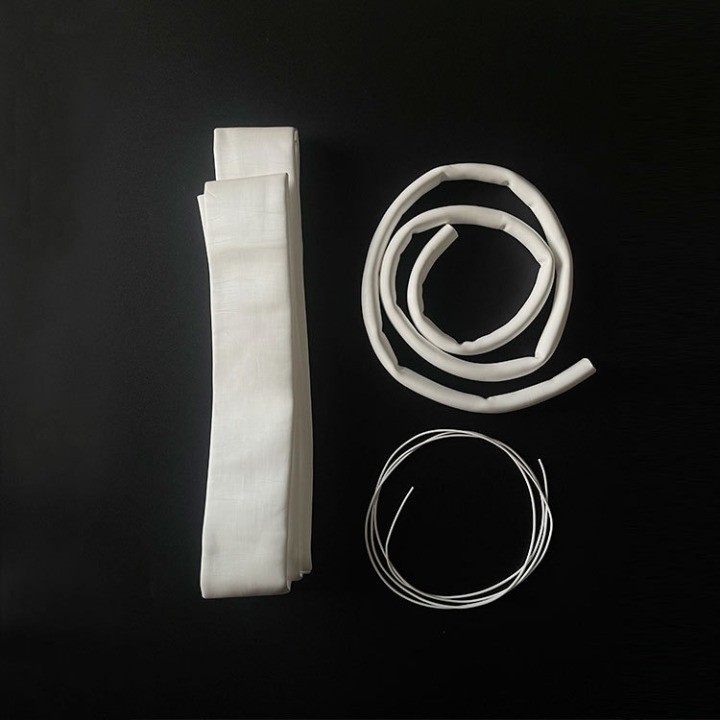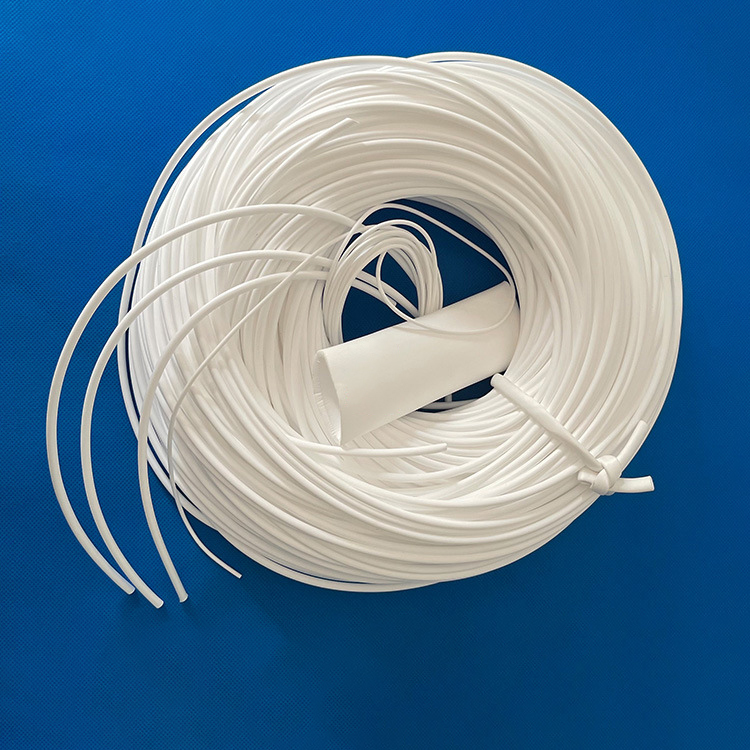The relentless pursuit of medical advancement is driving the development of increasingly sophisticated implantable medical devices. From life-saving cardiovascular stents to intricate neurostimulation leads and advanced drug delivery systems, these devices demand materials that offer unparalleled biocompatibility, durability, and performance. For years, expanded Polytetrafluoroethylene (ePTFE) has been a cornerstone material in this field. However, the evolution doesn’t stop there. Continuous ePTFE medical innovation is pushing the boundaries of what’s possible, leading to advanced ePTFE tubing solutions that are pivotal for the success of next-generation implantable technologies. At SUKO, we are at the forefront of harnessing these innovations to provide medical device manufacturers with superior ePTFE components.
The Enduring Excellence of ePTFE in Medical Applications
Expanded Polytetrafluoroethylene (ePTFE) is a remarkable fluoropolymer created by rapidly expanding PTFE under specific conditions. This process creates a unique microporous structure characterized by solid nodes interconnected by fine fibrils, resulting in a material that is both strong and porous. Its inherent properties make it exceptionally well-suited for medical applications:
- Biocompatibility: ePTFE is highly biocompatible and elicits minimal to no adverse reaction from the human body. It has a long history of safe use in implants, meeting stringent standards like ISO 10993.
- Chemical Inertness: It is resistant to virtually all chemicals and bodily fluids, ensuring material integrity and patient safety over long implantation periods.
- Low Coefficient of Friction: Its lubricious surface minimizes tissue trauma during insertion and reduces the risk of blockages in fluid pathways.
- Customizable Porosity: The manufacturing process allows for precise control over pore size, porosity, and microstructure. This is crucial for applications requiring tissue ingrowth, controlled permeability, or specific mechanical properties.
- Durability and Flexibility: ePTFE can be engineered to be exceptionally strong yet flexible, withstanding the dynamic environment within the human body.
- Low Thrombogenicity: The material’s surface properties contribute to reduced platelet adhesion and thrombus formation, critical for blood-contacting devices.
- Sterilization Compatibility: ePTFE can be reliably sterilized using common methods such as Steam (autoclave) and Ethylene Oxide (EtO) without degrading its properties. SUKO’s Medical Grade ePTFE Hose for Biocompatible Implantable Devices is steam-autoclavable.
- MRI Compatibility: ePTFE is non-metallic and does not interfere with Magnetic Resonance Imaging (MRI), allowing patients with ePTFE implants to undergo crucial diagnostic procedures.
These foundational characteristics have made ePTFE a material of choice. But the true excitement lies in how ongoing research and development are refining and expanding its capabilities.
Key Innovations Shaping the Future of ePTFE Tubing
The demand for smaller, more complex, and smarter medical devices necessitates continuous improvement in material science. Here are some of the key areas where ePTFE medical innovation is making a significant impact:
1. Enhanced Microporous Structures for Optimal Biologics Interaction
The microstructure of ePTFE is its defining feature. Innovations in controlling this microstructure are leading to:
- Tailored Pore Architectures: Beyond simple pore size, manufacturers like SUKO can now engineer complex pore gradients and anisotropic structures. This allows for microporous ePTFE medical tubing that can, for example, encourage cell adhesion and ingrowth on its outer surface while maintaining a smooth, non-thrombogenic lumen.
- Improved Tissue Integration: For devices like vascular grafts or soft tissue repair meshes, optimized porosity promotes better anchoring and integration with surrounding tissues, reducing the risk of migration or rejection. A study published in the Journal of Biomedical Materials Research Part B: Applied Biomaterials (Vol. 80B, Issue 2, 2007, pp. 268-276) highlighted the importance of pore size and interconnectivity in ePTFE vascular grafts for endothelialization.
- Controlled Permeability: For applications like implantable sensors or specific filtration needs, the ability to precisely control gas and fluid permeability through the ePTFE wall is paramount. SUKO’s ePTFE tubing boasts gas-permeable walls, outperforming materials like silicone in certain surgical applications.
2. Advanced Material Composites and Surface Modifications
Pure ePTFE is excellent, but combining it with other materials or modifying its surface can unlock new functionalities:
- Reinforced ePTFE: Incorporating reinforcing elements (e.g., nitinol wires, other polymers) within the ePTFE matrix can enhance kink resistance, burst strength, and torqueability, essential for advanced catheters and delivery systems.
- Surface Coatings & Treatments:
- Hydrophilic/Hydrophobic Coatings: Modifying surface wettability can improve device trackability, reduce friction, or control cell adhesion.
- Antimicrobial Coatings: Incorporating antimicrobial agents (e.g., silver ions) can reduce the risk of device-related infections.
- Bioactive Molecule Immobilization: Attaching growth factors, peptides, or other bioactive molecules can actively promote desired biological responses like healing or anticoagulation.
- Laminated Structures: Creating multi-layer ePTFE tubing with different properties in each layer (e.g., a highly porous outer layer for tissue ingrowth and a dense inner layer for barrier properties) is now feasible.
3. Customization at Scale: The Rise of Custom ePTFE Medical Solutions
One size rarely fits all in the medical device world. The ability to provide custom ePTFE medical tubing is a game-changer. This includes:
- Precise Dimensional Control: Innovations in extrusion and expansion processes allow for tighter tolerances on inner diameter (ID), outer diameter (OD), and wall thickness, even for micro-sized tubing. SUKO specializes in providing custom dimensions to meet specific device requirements.
- Varied Densities and Strengths: Depending on the application, ePTFE can be produced with varying densities, impacting its flexibility, tensile strength, and suture retention.
- Complex Geometries: Beyond simple tubes, ePTFE can be formed into more complex shapes, bifurcations, or tapered structures, reducing the need for secondary assembly steps.
- Integration of Radiopaque Markers: Incorporating materials like tantalum or platinum-iridium markers allows for clear visualization of the device under fluoroscopy or X-ray during implantation.
SUKO understands the critical need for tailored solutions. Our expertise allows us to collaborate closely with medical device designers to develop custom ePTFE medical tubing that precisely matches their unique performance criteria. Explore our Medical Grade ePTFE Hose for Biocompatible Implantable Devices | SUKO to see our standard offerings and inquire about customization.
4. ePTFE in Sophisticated Drug Delivery ePTFE Systems
The unique porous structure of ePTFE makes it an exciting candidate for localized and sustained drug delivery applications.
- Reservoir Functionality: The micropores within the ePTFE matrix can be loaded with therapeutic agents. The drug then elutes slowly over time at the implantation site, providing targeted therapy and minimizing systemic side effects.
- Controlled Release Kinetics: By carefully engineering the porosity, tortuosity, and thickness of the drug delivery ePTFE component, the rate of drug release can be precisely controlled.
- Combination Devices: ePTFE can be integrated into devices like drug-eluting stents, catheters designed for localized drug infusion, or implantable drug depots. For example, coating an ePTFE vascular graft with an anti-proliferative drug can help prevent restenosis.
- Biologics Delivery: The inert nature of ePTFE also makes it suitable for the delivery of sensitive biologic drugs, such as proteins or growth factors, protecting them from degradation.
The potential for drug delivery ePTFE is vast, promising more effective treatments for a range of conditions, from cardiovascular disease to chronic pain management.
Table: Key ePTFE Properties and Their Significance in Medical Devices
| Property | Significance for Medical Devices | SUKO’s Advantage |
|---|---|---|
| Biocompatibility | Minimizes immune response, inflammation, and rejection; safe for long-term implantation. | Meets ISO 10993 standards; proven track record. |
| Chemical Inertness | Resists degradation by bodily fluids and medications; maintains structural integrity. | Ensures long-term device stability and patient safety. |
| Microporosity | Allows for tissue ingrowth, controlled permeability, and drug elution. | Offers microporous ePTFE medical tubing with customizable pore structures. |
| Low Friction | Reduces tissue trauma during insertion; improves flow in lumens. | Enhances device deliverability and performance. |
| Durability/Flexibility | Withstands mechanical stresses in vivo; conforms to anatomical structures. | Provides robust tubing suitable for dynamic environments. |
| Low Thrombogenicity | Reduces risk of blood clot formation on blood-contacting surfaces. | Critical for vascular grafts, catheters; SUKO’s ePTFE outperforms silicone in many surgical applications. |
| Sterilizability | Compatible with standard sterilization methods (e.g., steam, EtO). | SUKO’s ePTFE is steam-autoclavable. |
| MRI Compatibility | Allows patients with implants to undergo MRI scans safely. | A key benefit for modern diagnostics. |
| Zero Extractables | Ensures no harmful substances leach into the body. | SUKO’s medical-grade ePTFE ensures purity. |
| Gas Permeability | Important for specific applications like oxygenation or sensor function. | SUKO’s ePTFE features gas-permeable walls. |
Applications Benefiting from Advanced ePTFE Tubing
The innovations discussed are broadening the scope of applications for advanced ePTFE tubing:
- Cardiovascular Devices: Vascular grafts, stent grafts (especially for endovascular aneurysm repair – EVAR), introducer sheaths, and catheter liners. The low thrombogenicity and tailored porosity are critical.
- Neurostimulation: Leads for pacemakers, defibrillators, and deep brain stimulators benefit from ePTFE’s biocompatibility, flexibility, and insulative properties.
- Drug Delivery Catheters: Specialized catheters for targeted drug infusion, leveraging drug delivery ePTFE capabilities.
- Implantable Sensors: Housings and interfaces for biosensors, where controlled permeability and biocompatibility are essential.
- Surgical Meshes and Patches: For hernia repair, soft tissue regeneration, and dural substitutes, microporous ePTFE medical materials encourage tissue integration.
- Endoscopy and Minimally Invasive Surgery: Components for steerable catheters, instrument lumens, and protective sheaths.
- Cell Encapsulation Devices: Protecting transplanted cells (e.g., pancreatic islets for diabetes treatment) from the host immune system while allowing nutrient and oxygen exchange.
Anonymized Success Story: A leading medical device company approached SUKO requiring a highly customized, thin-walled ePTFE liner for a novel neurovascular access catheter. The challenge was to achieve an exceptionally low friction inner surface, precise dimensional stability over complex curves, and enhanced radiopacity for visualization, all within a micro-diameter profile. Through collaborative R&D, SUKO developed a proprietary advanced ePTFE tubing solution that met all specifications, enabling the client to bring their next-generation device to market successfully, improving procedural outcomes for stroke patients.
SUKO: Your Partner in ePTFE Medical Innovation
At SUKO (https://www.sukoptfe.com), we are not just suppliers of ePTFE tubing; we are collaborators in medical device innovation. Our commitment to quality is underscored by our adherence to ISO 13485 standards, ensuring that every product, like our Medical Grade ePTFE Hose for Biocompatible Implantable Devices, meets the rigorous demands of the medical industry.
We leverage our deep Experience in fluoropolymer processing and our Expertise in ePTFE material science to provide solutions that push the envelope. Our ability to deliver custom ePTFE medical components, from intricate microporous ePTFE medical structures to specialized drug delivery ePTFE conduits, makes us an Authoritative leader in the field. The Trustworthiness of SUKO products is built on consistent quality, performance, and a commitment to patient safety.
Choosing SUKO means partnering with a team dedicated to understanding your specific challenges and delivering ePTFE solutions that enhance the performance, safety, and efficacy of your next-generation implantable medical devices. Whether you need standard tubing or a highly customized component, we have the capabilities and the innovative spirit to help you succeed.
Let’s Innovate Together
The future of implantable medical devices is intrinsically linked to material science advancements. Innovations in ePTFE tubing are paving the way for breakthroughs that can significantly improve patient outcomes.
Ready to explore how SUKO’s advanced ePTFE tubing solutions can elevate your medical device designs?
- Learn More: Visit our website at https://www.sukoptfe.com to discover our full range of capabilities.
- Explore Our Product: Check out the specifications of our Medical Grade ePTFE Hose for Biocompatible Implantable Devices | SUKO.
- Consult Our Experts: Have a specific challenge or a novel idea? We thrive on collaboration.
- Contact Us: https://www.sukoptfe.com/contact/
- Email Us: info@sukoptfe.com
Partner with SUKO and let’s shape the future of medical technology with cutting-edge ePTFE medical innovation.
Frequently Asked Questions (FAQ)
Q1: What makes ePTFE particularly suitable for long-term implantable medical devices?
A1: ePTFE’s exceptional biocompatibility (minimal bodily reaction), chemical inertness (resistance to degradation by bodily fluids), and microporous structure (which can be tailored for tissue integration or drug delivery) make it ideal for long-term implantation. Its proven history of safe use in millions of medical devices, coupled with its durability and flexibility, further solidifies its suitability. SUKO’s Medical Grade ePTFE Hose exemplifies these qualities.
Q2: Can SUKO provide ePTFE tubing tailored to very specific dimensions and porosity requirements for a novel device?
A2: Absolutely. SUKO specializes in custom ePTFE medical solutions. We work closely with medical device manufacturers to understand their unique requirements for inner diameter, outer diameter, wall thickness, porosity, density, and mechanical properties. Our advanced manufacturing processes allow us to produce highly customized advanced ePTFE tubing to meet the precise needs of your innovative device. Please reach out to us via our contact page to discuss your project.
Q3: How does SUKO ensure the quality and consistency of its medical-grade ePTFE tubing?
A3: SUKO adheres to stringent quality management systems, including ISO 13485 certification, which is specifically for medical device manufacturing. Our processes involve rigorous raw material selection, precise control over manufacturing parameters (extrusion, expansion, sintering), and comprehensive in-process and final product testing. This ensures that every batch of ePTFE tubing, including our microporous ePTFE medical products, meets the highest standards of quality, consistency, and performance for critical medical applications.
Post time: Jun-13-2025


